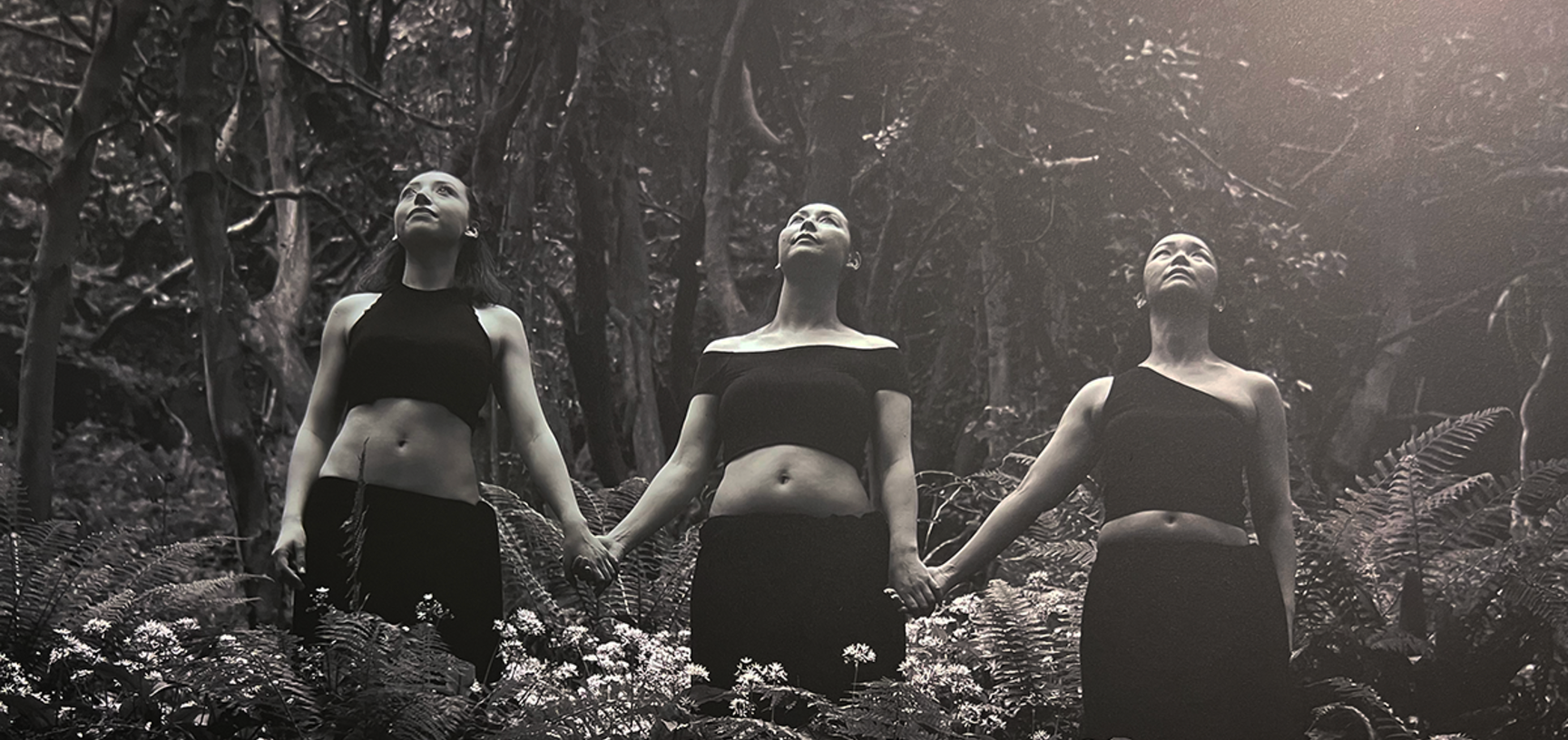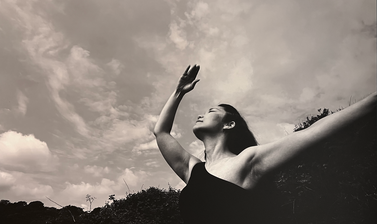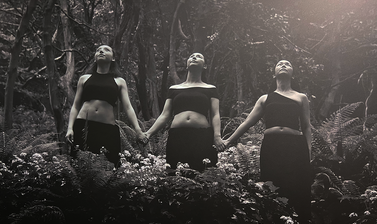Ola i ka wai | Water is life
The cultural dances of Hawaiian Hula and Tahitian 'Ori are a vital part of life and are present in religious ceremonies, social gatherings, celebrations, and everyday life. They contain the knowledge and collected memory of its peoples-- cultivated over generations-- from philosophy, science, art and craft, relationship to Earth, and the human condition. Presented through story, prayer, and entertainment, Hula and ‘Ori use specific movement language to represent given ideas, and maintain a sacred connection to Earth and the Cosmos. The dance forms act as a conduit between humanity and the divine, helping the participants to recognize that they are part of something bigger and that we are all connected.
Inspired by these concepts, the London School of Hula and 'Ori (LSHO) created choreography for the Ma uka to Ma kai exhibition that focuses on the source of life– Water. The choreography explores the water cycle, from four perspectives: Ocean, Sky, Earth, and Humanity, attempting to embody the essence of and give form to these elements. Water is central to the functioning of the ahupua’a and to life itself. Without water, there is no fauna in the forests, no crops, no streams to nourish us; simply, there is no life. Using movement from Hula, ‘Ori Tahiti, and contemporary motion, and combining the mediums of cinema, sound, music, and dance, the film aims to represent the intertwined and dynamic relationship between humanity and our environment. It encourages the viewer to acknowledge that we are a part of this cycle, that we are beholden to nature.
Since I can remember, I have been learning the stories of our ancestors– a rich world of myths and tales that contain the knowledge of the universe. I utilise these myths in my storytelling in order to provide crucial information about the world around us through the lens of womxn from the global majority – past, present, and future. These women – my mother, my grandmothers, my ancestors – who are able to call upon themselves, each other, and the sacred lands to which we are intrinsically bound, are central to the health of people and Earth, and thus the continuation of all life. I believe that ancestral knowledge is not a thing of the past, but holds the key to a healthy future.
Krysten
Everything in the universe is connected, whether it be the sky to the earth through the falling of the rain, or person to person through the infectious ease at which emotions can spread. This project showcased how important and moving it is to give in to that oneness with ourselves, nature, the world around us, and each other, and how none of us are isolated from that connection.
Danielle
Our existence as humans is so tiny but so profound, we sometimes forget how fragile and interdependent we are. Across cultures, we see stories that connect us to the elements and to something bigger, and it is our responsibility to be part of the lineage of these stories, to deliver them to future generations.
Akino
About the exhibition
The Long Gallery exhibition displays quilts from the Honolulu-based Poakalani Quilters that depict Hula through appliqued designs alongside a photographic series, Ola i ka wai, by Krysten Resnick and film depicting the London School of Hula and 'Ori. A selection of photographs from the series are shown on this webpage, along with the quilts on display.
About LSHO
London School of Hula and 'Ori is a cultural dance school and community that aims to uphold and reinterpret the practices of Hawaiian Hula and Tahitian 'Ori within a modern metropolitan context. By accessing and platforming traditional knowledge systems that combine movement, myth, ceremony, and community we are able to create healthier and more meaningful connections to the self, our wider communities, and our Earth and bridge the gaps between past and present-- all of which is necessary in shifting the trajectory towards a healthier future.
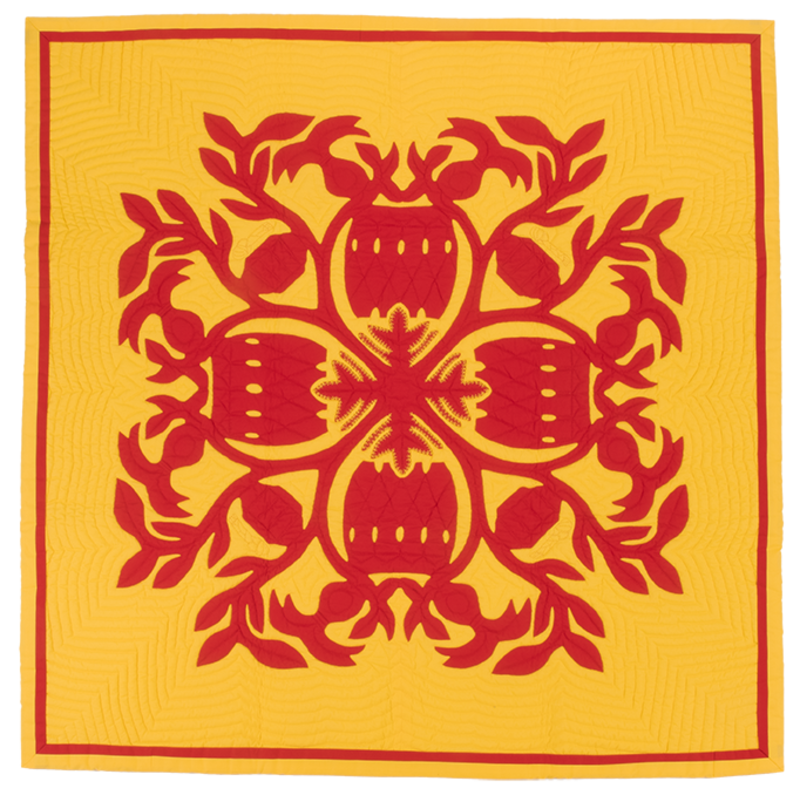
ā Mele ʻo Hula Kahiko (Songs of Hula). Quilted by Yoshimi Suzuki. Designed by John Serrao co-founder of Poakalani Quilters. PRM 2022.57.2
Stories from the Quilting Circle
by Yoshimi Suzuki
I started quilting with Poakalani in 2000 at the Royal Hawaiian Shopping and under the direction of Kumu (teacher) John Serrao I was able to receive my teacher's certification in 2006. I started my Quilting Class in Yokohama in 2006, called “Hālau Kuiki O Owyhee” (Quilt Class of Hawaiʻi) a name given to me by Kumu John. In the tradition of the Poakalani Class in Hawaii, I produced Quilt Shows in Japan every two years showcasing my students Quilts. In 2015 I received the highest honour from Kumu John my Hawaiian name “POMAIKALANI” which means blessings from heaven.
The motifs on this quilt are Pahu hula(drum), ʻUli ʻuli(feathered rattles), Pūniu( coconut knee drum) used in classical hula dancing and Maile leaves represents Laka (Goddess of hula). In this way they are related to Hawaiian life. The central part has Wāwae Moa (chicken feet stitches) which is one of the traditional techniques.
When DESIGNER and QUILTER have pens or needles, we think about the history and the traditions of Hawaiʻi, or the lifestyle of the time still exists. By reviving and expressing them, we play a role in conveying the history of Hawaii, the royal family (Aliʻi) and Hawaiian culture.
John & Poakalani family has a history of learning the original techniques on the ship Thaddeus boarded by missionaries in the 1820. It’s great honour for me to learn from them who are the ancestors of the tradition, which is now loved all over the world.
We hope that people around the world will be interested in the culture and traditions of Hawaiʻi through our Hawaiian quilts.
The tradition continues…
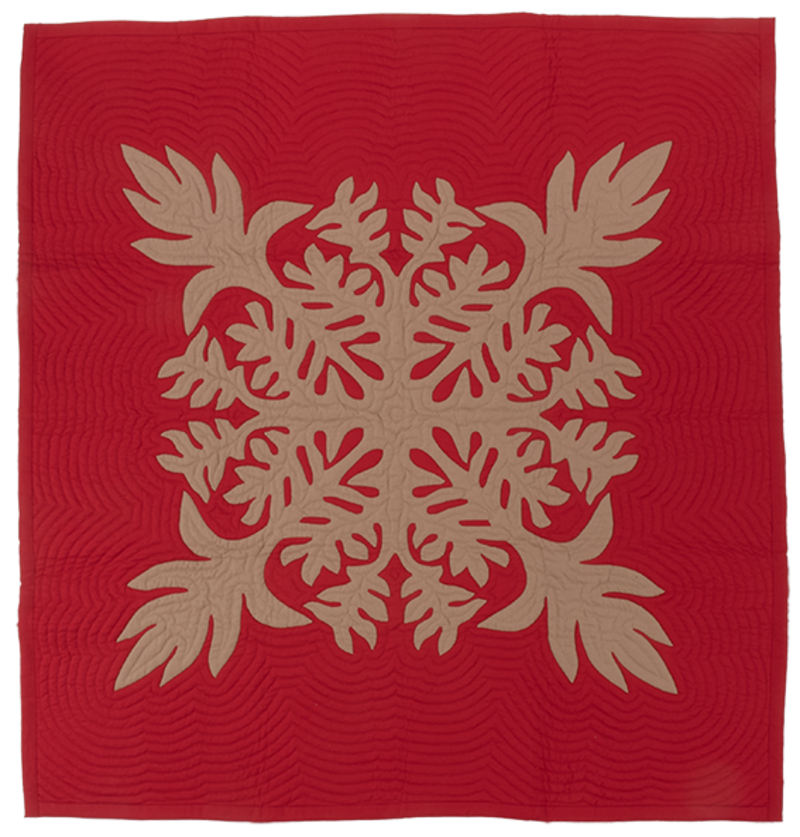
Ti Leaf and Lauaʻe. Quilted by Pat Gorelangton. Designed by John Serrao. PRM 2022.57.12
Wai ʻapu lau kī.
Water in a ti-leaf cup.
[When one goes to the upland and needs a cup to dip water from the stream or spring, he folds a ti leaf to form a dipper.]
Stories from the Quilting Circle
by Pat Gorelangton
I have been a quilter for almost 40 years. Though I've tried other quilting styles, once I joined the Poakalani Quilt Group 18 years ago, Hawaiian quilting became my passion. To me, it has the symmetry that appeals to my sense of order, while also having a beautiful freedom of movement...especially in the designs of John Serrao. John was a master designer; it was a privilege to learn from him. The knowledge and support that the entire Serrao ohana (family) has given to me over the years is nourishment for my soul. One of my favourite things to do is to complete a quilt that was started by someone's grandmother or auntie years ago...but any time I can make a quilt, whether as a commission, or an idea I had and am trying to express, is truly a joy.
So much of the Hawaiian quilt patterns are inspired by our plants and our culture. This Ti Leaf and Laua'e quilt is one of John's beautiful designs. There are two kinds of laua'e fern...one comes from Australia, and the other much rarer one is indigenous to the Hawaiian Islands. It has a faint but lovely fragrance and is used in gardens as well as floral arrangements. The ti leaf has many uses in Hawaiian life; from religious ceremonies to food wrapping, to skirts for hula dancers, and lei for ceremonies.
I've made over 170 Hawaiian wall hangings and bed quilts and have been part of articles and videos about Hawaiian Quilting over the years, which I hope to have conveyed my love of this beautiful, cultural art of Hawai'i.
